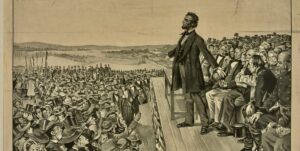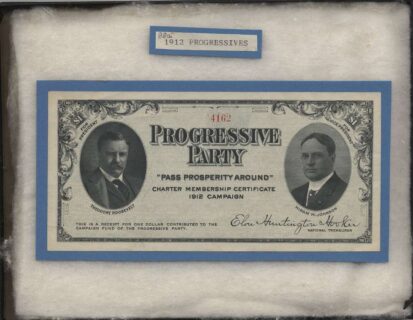
The Progressive Challenge to the Founders' Principles
An Interview with Jason Jividen
This month we are featuring our core document collection Populists and Progressives, edited by Jason Jividen. Dr. Jividen, who teaches politics at St. Vincent College in Latrobe, PA, specializes in political philosophy and the political thought of Abraham Lincoln. He is author of Claiming Lincoln: Progressivism, Equality, and the Battle for Lincoln’s Legacy in Presidential Rhetoric (Northern Illinois University Press, 2011); coauthor, with J. David Alvis, of Statesmanship and Progressive Reform: An Assessment of Herbert Croly’s Abraham Lincoln (Palgrave Macmillan, 2013); and numerous articles on progressivism, presidential statesmanship, and civic education. In the Master of Arts in American History and Government program, Jividen frequently teaches “The Progressive Era.” Recently, we asked Jividen about the collection he compiled and his experience discussing American progressivism with teachers in TAH programs.
Teachers are often surprised to find that the progressive era course, as taught in the MAHG program, presents not the social problems the progressives wanted to solve so much as their political theories. How do you present the era in your document collection?
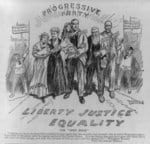
The textbook approach to progressivism, especially among history teachers, tends to focus on social movements and social reforms. We need to understand that history. But such an approach can oversimplify the motives and impact of progressive reformers. Many of us who teach in MAHG find the progressives’ ideas much more complicated and consequential than such an account would imply. Politicians and theorists of the late 19th and early 20th centuries were discussing fundamental political issues that concerned first principles: What are the purposes of government? How should government fulfill those purposes? Often disagreeing with earlier generations about the purposes of government, they also disagreed about the means to achieve those purposes.
I’m a political theorist, and I tend to think in that way. But I offer this document collection as a supplement to that more bread-and-butter historical approach that a lot of teachers are already very familiar with. When I teach the progressive era course, I tell MAHG students, “You know as much and probably a lot more than I do about what happened during this period. You tell me the history, and I’ll help you read the progressives’ and populists’ theories.”
For many of our students, the theoretical content of the course is a new thing. Although the documents in the collection have been excerpted, much progressive writing is difficult to read, dense, and arguably wordy. I know many MAHG students delay taking the progressive era course until they have almost finished their coursework. Actually, that makes for a very lively class, because they are well prepared to discuss the progressive critique of the founders.
In the introduction to the collection, I suggest that readers consult Gordon Lloyd’s collection The Founding as they read this one, contrasting the progressive arguments with excerpts from The Federalist or Madison’s convention notes. This helps readers see the novelty of progressive ideas in the American political tradition.
Some excerpts in your collection do present the issues in terms teachers will find familiar. Henry George’s Progress and Poverty presents a troubling contradiction: industrial progress, instead of improving the lives of workers, has perpetuated or increased their suffering.

Many see the progressive movement as a response to the perceived challenges presented by a new, industrial economy after the Civil War. Average people are often having a hard time making ends meet in an economy that fosters an unprecedented concentration of wealth, increasing economic specialization, and changed working conditions. The frontier is closing so they can no longer go west to become yeoman farmers. They find themselves increasingly dependent on dangerous factory work, urban living, and wage-earning.
To deal with these issues, progressives argue for a reevaluation of the political formulas that persisted up until the end of the 19th century. Most say we must first of all give government at all levels more direct power to regulate the economy. Most equate founding era liberalism with laissez-faire limited government. I think they exaggerate the framers’ views, attributing to them a radical libertarianism foreign to Madison or Hamilton. But it serves their narrative to paint the framers in this way.
Second, many progressives want to give the people more direct control over this more powerful government. They promote efforts to simplify procedures for constitutional amendments and initiate legislative referenda at the state and federal levels. Many progressive theorists and politicians push referenda to recall public officers. Some, like Teddy Roosevelt, even argue for the popular recall of unpopular state court decisions. Arguably, such proposals sometimes get pretty radical, but they spring from a new kind of public philosophy.
Many documents in your collection exhibit a new optimism about government. I’m struck by Woodrow Wilson’s first essay in the book, which dismisses many of the worries that preoccupied the authors of The Federalist.
Wilson is unusual in being both an academic and a politician, and his early essays confidently invoke Hegel’s view that human thought expresses the essence of the historical era. Yet his views align with those of other progressives, like Roosevelt, who write about government administration. To Wilson, separation of powers is less necessary in an era that understands human nature, competent administration, and—most important—the true ends of government. Concentration of power is only dangerous if it’s misused. In fact, concentrating power in one place allows the people more oversight. If we disperse power, too many officials can hide behind closed doors. If one person is making all the decisions, we know exactly who to point the finger at when things go south.
This runs counter to Federalist 51, which argues that government must take account of our imperfect human nature. In their understanding of human nature, the progressives and the framers part ways. The founders take a decidedly realistic view. Whatever progress we make in the science of politics, human nature will remain imperfect, they say. Faction will always threaten popular government. No human being can ever be trusted with absolute and arbitrary power.
Wilson, Roosevelt, Herbert Croly and others believe human nature will improve as history progresses and education becomes more widespread. Some progressives even talk about eugenics, arguing that human nature can be improved through better breeding.
In “The Right of the People to Rule,” Theodore Roosevelt dismisses out of hand the central problem Madison discusses in Federalist 10. Roosevelt says majority tyranny no longer threatens democracy; the real problem is the tyranny of the minority—the wealthy special interests—over the rest of us. I always invite students to think about that. Is there anything to Roosevelt’s argument? If so, then some Madisonian institutions may well be obsolete. If not, then perhaps Madison and the framers still have something to teach us about designing a polity.
Do students question the progressives’ concerns with corrupt government officials? That concern seems to contradict their willingness to empower directly elected government officials to fight the special interests.
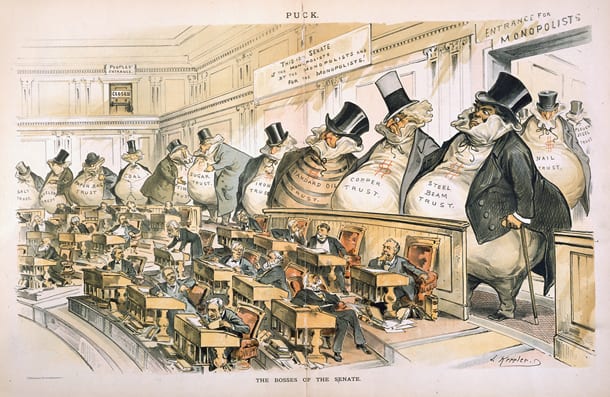
Not all progressives are equally enthusiastic about direct democracy. Wilson seems more ambivalent than others. He gets behind the direct election of Senators but not necessarily legislation through referenda or the recall of elected officials. He focuses much more on administrative expertise. In fact, it’s one of the great legacies of Progressivism to distinguish the political and administrative realms.
Wilson says administrators, who are experts in their fields, are released from direct popular control, being appointed rather than elected, so that they can do their jobs without worrying about politics. It’s not a crazy argument; it recognizes one of the real problems with democratic government. Politicians, on the other hand, express the will of the people—while trying to guide that will and set policy goals. Teachers who read Wilson’s essays on administration, opinion leadership, and the presidency soon realize that he describes the way the federal government operates today. The president explains to the public what our most pressing problems are and how we ought to go about fixing them; the administrative apparatus does the work. The president’s main job becomes persuasion, especially today in the age of digital communication.
Persuasion has its limits, however. Wilson says leaders cannot get too far in front of what the people are already thinking; he brings to the surface ideas that are latent in them. Pointing to the eloquent orator and British parliamentarian Edmund Burke, who lost on every big issue, Wilson says he got too far ahead of what people were thinking. He praises Lincoln as a man of the people—not because he grew up in a log cabin but because he has “sympathy” for public opinion. Presidents need vision, but they cannot reveal all they see.
Of course, Lincoln always returns to timeless natural rights principles, whereas Wilson emphasizes progressive history and the evolution of policy. The progressives routinely make both Jefferson and Lincoln, to the extent they are useful, heroes of their movement; but when these heroes stand for unchanging principles of government, the progressives often see them as “men of their time.”
Immigration, which increased dramatically during the progressive Era, concerns progressive politicians and activists, but they take different approaches. Jane Addams wants to help immigrants assimilate into US society. Wilson seems to want to assimilate them into the progressive governing coalition.
Addams’s philanthropic work aligns with the social gospel movement—she offers Christian charity and friendship to the newcomers. But politicians worry about electoral coalitions. This relates to your question about corruption in government. As a young man, Wilson gave a famous speech to the American Political Science Association, telling his fellow professors to get over teaching the Constitutionally outlined procedures of government. These procedures don’t fully explain politics; you also need to know about backroom deals and even graft.
He says academics should stop decrying “corruption” in the parties’ city organizations. When progressives talk about corruption in the political machines, they are often talking about immigrant voting patterns and the boss system. The bosses gained influence over the immigrant vote by taking care of problems like garbage disposal and mail delivery. You can see this in the party platforms. The emphasis on sunshine laws, short ballots, secret ballots, and so on indicates a concern with the immigrant vote. We could not cover too much of that in the collection, but the conflict between the real philanthropic concerns of some of the reformers and the hard-nosed political concerns of the party establishment can be seen in many documents.
What document in the collection might most surprise readers?
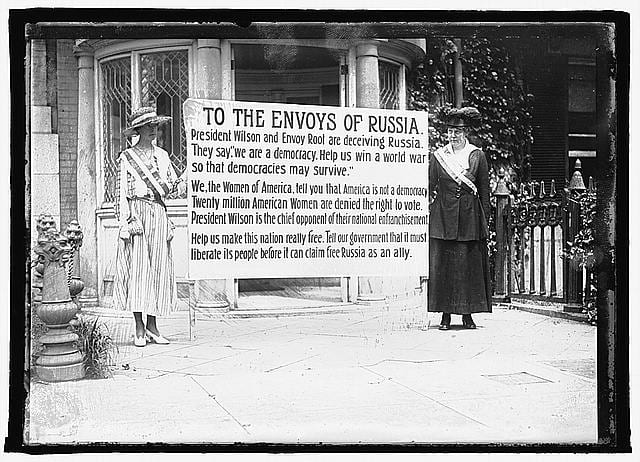
Jane Addams’ “Why Women Should Vote” evokes strong reactions from teachers in the progressivism course. Addams does not assert the political rights of women; she cites a practical concern. Women need to vote because they see problems in the cities that men overlook. The assumption was that men vote for their households, but if that were true, Addams argues, we would not see in the cities problems with neglected sanitation, substandard education, unsafe rental housing, and so on. Say whatever you want about women’s equality with men; women need to vote in order to protect their families.
Some MAHG students are outraged that Addams does not assert women’s equality. Others say, this is genius! She’s found a way to appeal rhetorically to conservative women who occupy traditional roles as housewives and mothers. In fact, Addams first published the piece in Ladies Home Journal.
Are we still dealing with the issues the progressives raised and the changes they wrought in our system of government? Is their challenge to the Founders still a live issue?
Some historians speak of the progressive movement as a discrete period occurring between the 1880s and 1920s. I think the movement is as much alive today as it ever was. Many who had a home in progressive thought found a home in New Deal liberalism. Politically, they saw the fruition of their movement in the New Deal understanding of the presidency and the administrative state. When FDR accepted the nomination in 1932, he said Democrats were following in the footsteps of their captain Woodrow Wilson. Progressive thought did not culminate in the New Deal; it still looms large over how we understand administration and especially the presidency. No matter what party you’re in, everybody owns that understanding now.
Progressivism never went away because it was not merely a political movement. It was also an intellectual, academic movement that found a home on college campuses. Social science departments in particular are overwhelmingly dominated by progressive thinking. At the turn of the century, certain progressives like Charles Beard and J. Allen Smith argued that the Constitution was written by aristocratic white men who were trying to secure their own interests over the good of the many. Smith said the Constitution was shot through with supposedly antidemocratic obstacles to the true will of the people. We needed to reinvent the Constitution, he argued, either through reinterpretation or through amendment. That’s the way I was taught the Constitution by most of my history professors in college. I would argue that the prevalence of social history in academia owes very much to the progressive view that history charts the successive overcoming of prior generations’ ways of thinking. We’re still asking a lot of the same questions. Can we still be informed or guided by the views of Madison, Hamilton or Jefferson? In compiling the document collection, I tried to focus on these questions and invite teachers to discuss them with students.

